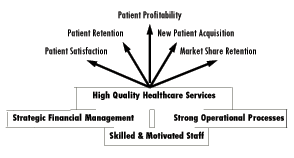
|
Join
our Mailing List!
|
|
|
We can learn to soar only in direct proportion to our determination to rise above the doubt and transcend the limitations.
Strategic management consists of those activities that come in the aftermath of strategic planning to bring the plan to life. It may seem only logical that these activities would occur but it is estimated that 95% of all strategic plans are never fully implemented and many never make it out of the starting gate. Too often the strategic plan turns out to be nothing more than a document that sits on the shelf in the CEO’s office and is dusted off periodically.
While organizations always have good intentions, the pressures of day-to-day activities and reliance on traditional management techniques create an environment where the strategic plan become a casualty. It is estimated that the average organization spends less than two hours a month seriously evaluating the implementation of their strategic plan and planning for its success. When you consider the twelve to fourteen hours per month spent on evaluating compliance with the annual budget, it is understandable how easy it is for an organization to get caught up in perpetuating the present or past instead of creating a future.
Strategic management creates the structure and the coordination of activities that drives the strategic plan to success. Strategic management is about aligning people and resources to achieve success. These activities include:
Patient satisfaction, patient retention, patient profitability, new patient acquisition and market share retention are the five critical areas to monitor and develop for the future success of healthcare organizations. These are normally the key areas that most strategic plans should address in some way.
Over the past decade, efforts have focused primarily on trying to manage financial aspects of a healthcare organization to better position the organization for survival. Unfortunately, a predominantly financial focus often devalues what patients perceive to be important and those internal development activities that promote growth. The long term outcome is often continued decline in patient volumes, a high number of errors, declining quality, loss of staff, inefficient operations, and the failure of staff skills and abilities to keep up with the rapidly changing environment.
Success in today’s market is about building a stronger immediate present while, at the same time, creating the future of the organization. Strategic management takes a good strategic plan and manages the organization’s resources to make that plan a reality while keeping the activities moving along in the “Change-Ready Zone.” For a healthcare organization, it means taking the collective abilities and potential of all the resources available to the organization and focusing them for success by promoting opportunities and overcoming challenges.
Strategic Management


![]()
Home
| About Us | Services
| Solutions in Healthcare
Newsletter | Contact
Us | Links | SiteMap
D.D.
Bainbridge & Associates, Inc.
595 Lyndon Center Road - Cuba, NY, 14727 US
info@ddbainbridgeassoc.com
716-676-3635

